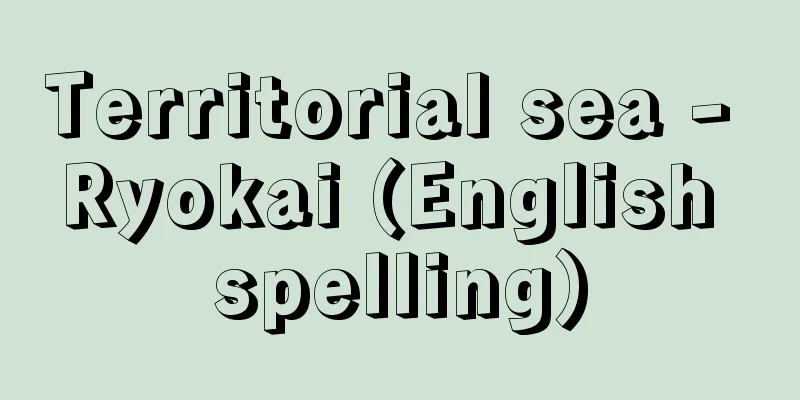Territorial sea - Ryokai (English spelling)

|
A strip of sea along the coast that has a certain width and that is considered part of the territory of a coastal state, including the airspace above and the seabed. The limits of the territorial sea are determined by the distance from the coast, and the starting point for measuring this range is called the baseline of the territorial sea, and the distance from the baseline to the outer limit is called the width of the territorial sea. The waters on the land side of the baseline are called internal waters, and are distinguished from the territorial sea. [Takabayashi Hideo] Baselines of territorial watersOn a flat coast, the baseline is the low-water line of the coast as shown on the chart of the coastal State. Where the coastline is very indented or where there is a series of islands fringing the coast in the immediate vicinity, the baseline may be drawn by drawing a straight baseline between suitable points. The straight baseline must not deviate significantly from the general direction of the coast. The different baselines affect the extent of the territorial sea, but the coastal State may determine, in its sovereignty, which baseline to use. In the case of a bay whose mouth is a clear inlet not exceeding 24 nautical miles, the baseline is a closed line connecting the entrance. In the case of a harbour, the baseline is the outermost permanent harbour work, and in the case of a river, a straight line drawn at the mouth of the river. The 1982 United Nations Convention on the Law of the Sea defined an archipelagic state as a nation consisting only of islands scattered throughout the ocean, determined the straight lines connecting the outermost islands of the archipelago as archipelagic baselines, and stipulated that the territorial sea of an archipelagic state is measured outward from these archipelagic baselines. However, the waters enclosed within the archipelagic baselines are called archipelagic waters, and although they are part of the territorial waters of an archipelagic state, they have their own legal status that is different from internal waters. [Takabayashi Hideo] Width of territorial watersUntil now, there had been no clear rules regarding the width of territorial seas. Three international conferences had been held to determine the width of territorial seas internationally: the Hague Codification Conference in 1930, the First Law of the Sea Conference in 1958, and the Second Law of the Sea Conference in 1960. However, all of these conferences ended in failure. This was because the interests of fishing and maritime traffic conflicted over the determination of the width of territorial seas. In response, the United Nations Convention on the Law of the Sea, adopted by the Third Law of the Sea Conference in 1982, succeeded in creating rules that provided for the establishment of an exclusive economic zone 200 nautical miles from the coast outside the territorial sea, and that coastal states have the right to determine the width of their territorial seas within a range not exceeding 12 nautical miles measured from the baseline, provided that all countries' ships and aircraft have the right of transit passage in international straits. This marked the first time in the history of international law that a rule regarding the width of territorial seas was established. In addition, when two countries have opposite or adjacent coasts, neither country may extend its territorial sea beyond a median line equidistant from the baselines of both countries, unless otherwise agreed. [Takabayashi Hideo] Right of passage through territorial watersTerritorial waters are part of a nation's territory, through which ships of all nations may enjoy innocent passage. This is a limitation of territorial rights imposed on all nations that have territorial waters in the interest of international traffic. Innocent passage is a passage that does not prejudice the peace, order or security of the coastal state. Furthermore, in those parts of territorial waters that fall into international straits, ships and aircraft of all nations may exercise the right of unimpeded transit passage. Transit passage is the exercise of freedom of navigation and overflight for the purpose of continuous and speedy transit. [Takabayashi Hideo] “Research on the territorial sea system” by Hideo Takabayashi, 3rd edition (1987, Yushindo Kobunsha) ▽ “Law of the Sea” by Soji Yamamoto (1992, Sanseido)” [References] | | |Source: Shogakukan Encyclopedia Nipponica About Encyclopedia Nipponica Information | Legend |
|
海岸に沿って一定の幅をもつ帯状の海域であって、領海の上空および海底を含めて沿岸国の領域の一部とされる海域をいう。領海の限界は、海岸からの距離によって決定されるが、この範囲を測定するための起算点の位置を領海の基線といい、基線から外側の限界までの距離を領海の幅という。基線より陸地側にある水域を内水とよび、領海とは区別されている。 [高林秀雄] 領海の基線平坦(へいたん)な海岸では、沿岸国の海図に示された海岸の低潮線が基線になる。海岸線が非常に曲折していたり、すぐ近くに海岸に沿って一連の島が縁どっているような場所では、基線を引くに当たって、適当な地点間を結ぶ直線基線の方法を用いることができる。直線基線は海岸の全般的な方向から著しく離れて引いてはならない。基線の引き方によって領海の範囲が異なることになるが、いずれの基線を用いるかは、沿岸国が主権にもとづいて決定することができる。湾口が24海里以下の明白な湾入である湾の場合には、入口を結ぶ閉鎖線が基線になる。港の場合には、もっとも外側にある恒久的な港湾工作物が、また河川の場合には河口に引いた直線が基線になる。なお、1982年の国連海洋法条約では、大洋中に散在する群島だけから構成される国家を群島国家と規定して、群島のもっとも外側にある島相互を結ぶ直線をもって群島基線とし、群島国家の領海は、この群島基線から外側に向かって測ることを定めた。もっとも、群島基線の内側に囲まれる水域を群島水域とよんで、群島国家の領水の一部ではあるが内水とは異なる独自の法的地位をもつ水域とした。 [高林秀雄] 領海の幅これまで領海の幅について明瞭(めいりょう)な規則は存在しなかった。領海の幅を国際的に決定するために、1930年のハーグ法典化会議、1958年の第一次海洋法会議、1960年の第二次海洋法会議と三度の国際会議が開催されたけれども、いずれも失敗に終わった。これは、領海の幅の決定をめぐって、漁業上の利害と海上交通上の利害が対立したからであった。そこで、1982年に第三次海洋法会議が採択した国連海洋法条約では、領海の外側に距岸200海里の排他的経済水域を設立すること、および、すべての国の船舶と航空機が国際海峡において通過通航権をもつことを条件にして、沿岸国は基線から測って12海里を超えない範囲で領海の幅を決定する権利をもつという規則を作成することに成功した。ここに、国際法史上に初めて領海の幅に関する規則が成立したのである。なお、2国間で海岸が向かい合っている場合または隣接している場合には、いずれの国も、別段の合意がない限り、両国の基線から測って等距離になる中間線を超えて、その領海を拡張することができないことになっている。 [高林秀雄] 領海における通航権領海は国家領域の一部であるが、すべての国の船舶が領海内を無害通航することができる。これは、国際交通の利益のために、領海をもつすべての国に課された領域権の制限なのである。無害通航というのは、沿岸国の平和、秩序または安全を害しない通航のことである。また、領海のなかでも国際海峡に該当する部分においては、すべての国の船舶と航空機は妨げられない通過通航権を行使することができる。通過通航とは、継続的で迅速な通過の目的のために航行と上空飛行の自由を行使することをいう。 [高林秀雄] 『高林秀雄著『領海制度の研究』第3版(1987・有信堂高文社)』▽『山本草二著『海洋法』(1992・三省堂)』 [参照項目] | | |出典 小学館 日本大百科全書(ニッポニカ)日本大百科全書(ニッポニカ)について 情報 | 凡例 |
<<: Understanding Psychology - ryoukaishinrigaku (English spelling) verstehende Psychologie German
Recommend
Takemoto Settsu Daijo
Born: March 15, 1836, Osaka [Died] October 9, 1917...
Cerano (English spelling)
Around 1575 - 1632 Italian painter. His real name ...
Takemoto Kotosa
Year of death: January 1, 1977 Year of birth: Apri...
Yavorov, Pejo Kracholov
Born: 1877. Chirpan [Died] 1914. Sofia. Bulgarian ...
Kojiro Matsukata
Year of death: June 24, 1950 Year of birth: Decemb...
81/2 - One in two (English) Otto and mezzo
An Italian film made in 1963. In black and white. ...
Quathlamba
The Drakensberg is a region of the South African ...
Interest tax - Rishizei
When permission is granted to defer payment of inc...
Sabina virginiana (English spelling)
… [Toshio Hamatani]. … *Some of the terminology t...
Smoking - Kitsuen (English spelling)
Smoking is difficult to quit because it is a ment...
Auric, G. (English spelling) AuricG
…As in the second period, there was a lot of cont...
Summary of Law Books - Hoshoyoroku
A collection of documents on Chinese calligraphy. ...
cosmic physics
...It covers planets, the solar system, the sun, ...
Education Tower
…Other functions performed by the national organi...
Sulfur monofluoride
… [Disulfur difluoride] Chemical formula: S 2 F 2...

![Gyoda [city] - Gyoda](/upload/images/67cb5ce992d5d.webp)







